ARCHITECTURE IN MUTATIVE ENVIRONMENTS - CREATING DEGRADABLE SPACES
Our team studied the region of evros as a region of many alterations both natural and social and noticed that it is a field of constant flows. We rapidly focused on the migration flow because of its criticalness nowadays and its association with the geopolitical position of Evros.
We started by trying to find the factors that control and guide this flow. So we noted the following control factors that also have an intensive presentation on the area of Evros:
1. The military forces as a human flow which, canalizes the refugee flow
we mapped on one side concentration camps, police departments and reception centers for refugees, and on the other side spots that constitute common illegal passages of the immigrants as a representational tool we used a grid, a system of normal defined points with certain hierarchy and position.
The grid represents order and hierarchy whilst a distorted grid represents the resolution and questioning of this hierarchy
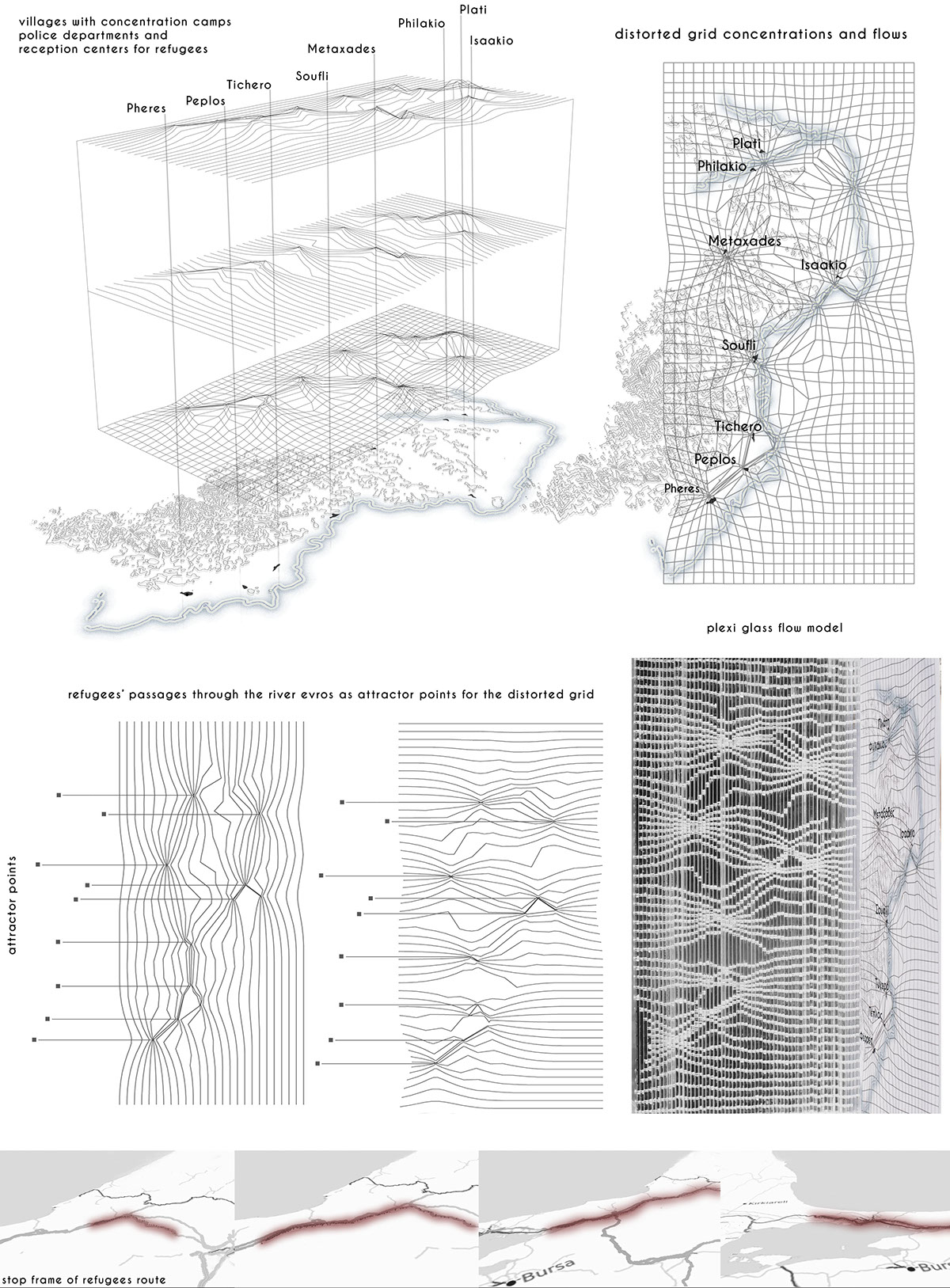

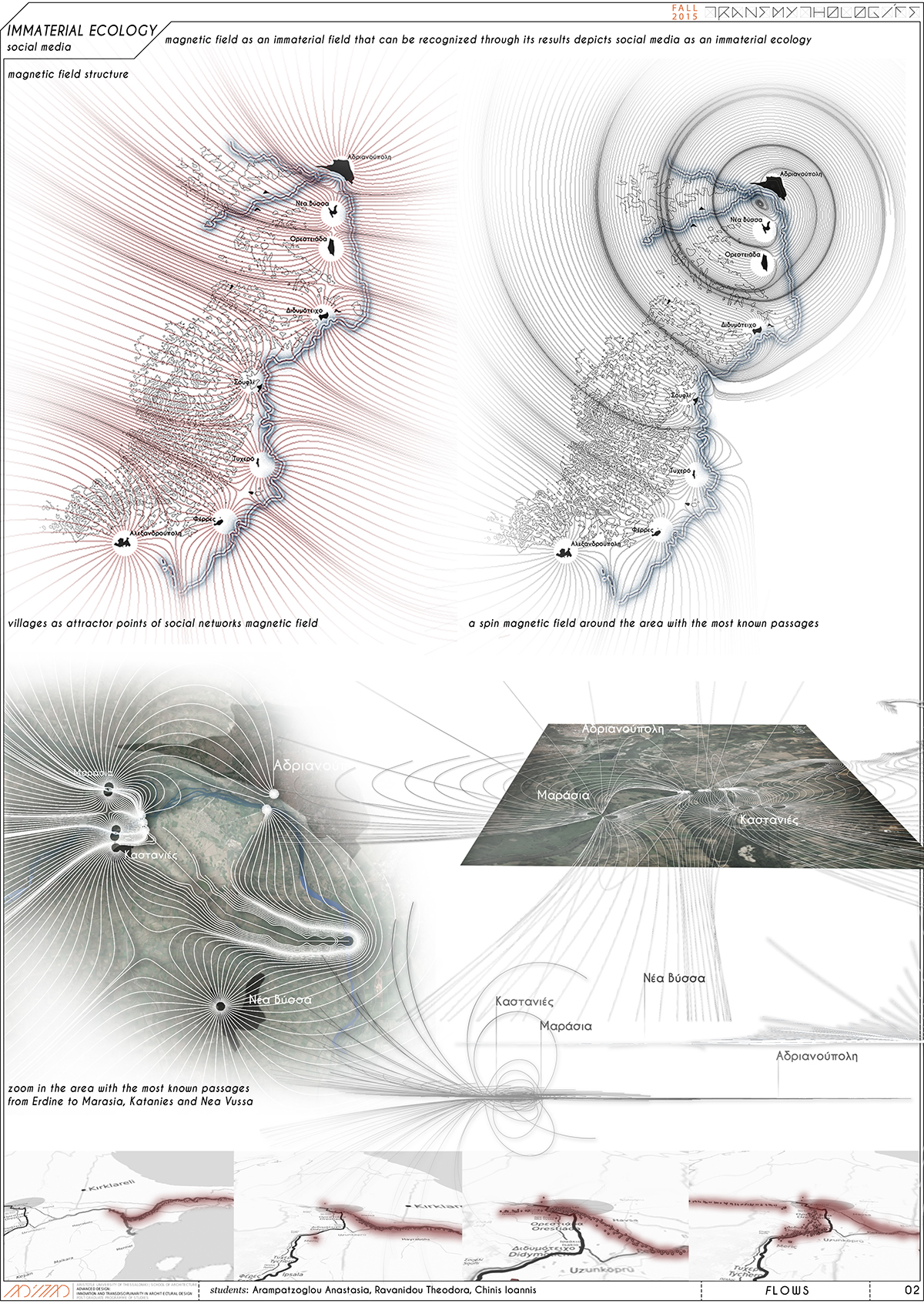
2. Accordingly, we approach social media as an immaterial ecology that directs and guides by giving information about safer passages and refugee gathering points. Thus, we used a magnetic field as an immaterial field that can only be viewed through its inherent and perceived actions of attraction and repulsion.

3. The third factor, natural environment of Evros and Ardas that create concentrations based on several characteristics such as flora and fauna, various materialities to be studied at a later phase of the project and amongst many more, terrain altitudes on which we focus in our diagrams.
Noticing that these three factors not only control the refugee flow but also influence and affect it, we concluded that there exist an interaction of flows with each other but only beacause there is a filter attracting these flows, in our case the border on Evros river.
The next step was to approach the behavior of flows in interaction with different types of filters, in a more palpable way. We proceeded to the creation of a machine using multiple types of filters and flows in order to conceptualize the interaction between them. So we came up with notional concepts such as concentration, osmosis, diffusion or absorption.
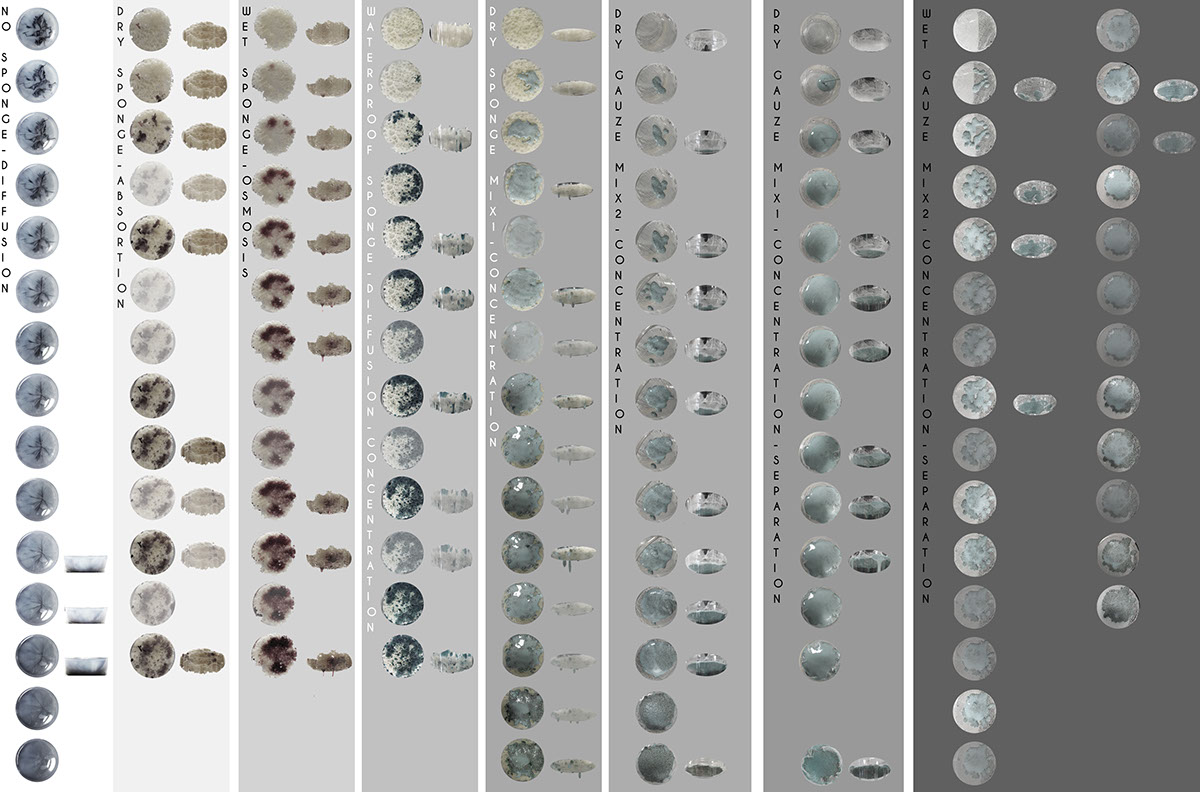
Trying to find a way to control the filter and study more thoroughly the interaction with a flow, we resulted in a filter made as a tissue that condenses and dilutes by our design intention. As a flow we used a wax mix in order to produce a more stable and visible result. In this final experiment we achieved the maximum control over the filter and how it interacts with our flows.



Moving forward the experimental process translated digitally in order to achieve certain types of concentration over a filter.
Noticing that in our experiment, matter uses the tissue's intersections as attractors, we created a system of multiple grids with its intersections serving the role of positive and negative poles for the creation as a magnetic field.

Over the field lines, matter is placed in similar way as in the experiments.
We started with simple magnetic fields and added complexity and multiplicity by controlling the number of the superimposition of several grids, the number of the field lines, the amount of charge and the selections of attractors and repellers.
In the final phase we pour matter in multiple phases. This pouring gives certain and various types and amount of concentration as a result.



Moving to the final phase, we went back to the analysis and restudied what evros means and defined some possible intruders and needs to organize a diagram with different space qualities.
The site and the special character of Evros region, provide us with a multitude of possible intruders. Intruders that are not only using or maybe inhabiting a predefined structure, but they are becoming a part of a project to be.
(i)Human beings, (ii) the rich biota (flora & fauna) that someone could encounter on site and (iii)the presence of the digital element are defining a set of intentions and needs that could be translated spatial to a mutable, adjusting and ever-changing built environment. [For instance the need of a group of refugees for philoxenia, would trigger the creation of a sufficient space arrangement to host its realization.]
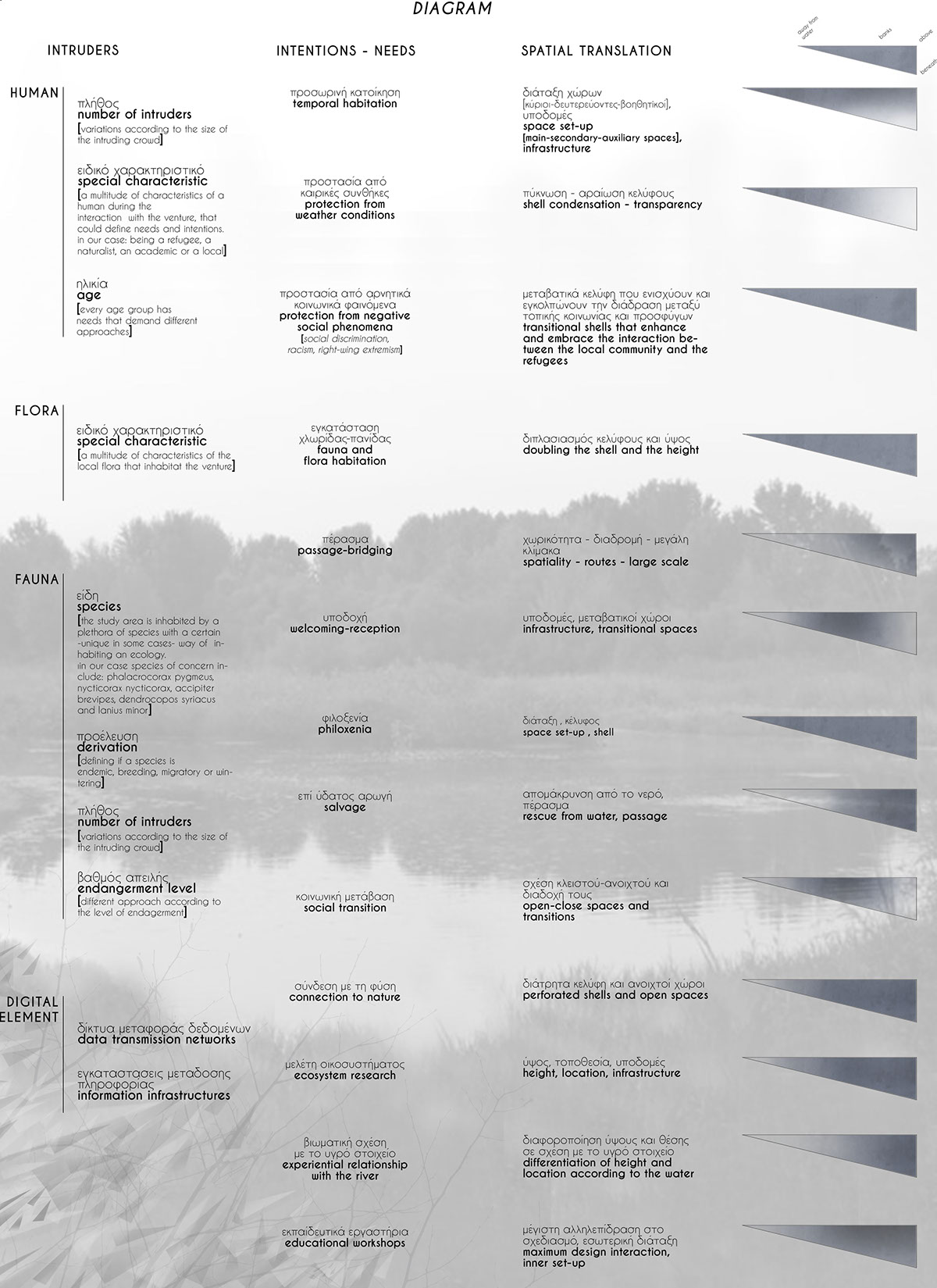
Our case scenario -the site on the border line near Marasia, one of the refugee passages in the vicinity of Edirne [a gathering place for the refugees]- allow us to approach and manage different types of intruders, such as refugges but also researchers and locals. On the next step their intentions are spatially translated after the interaction with the venture.

The randomness of the machine is left behind and we use certain points for a magnetic field creation. Starting with the two closest points on the banks, a field is created using certain heights. We pose attractors in 3 meters, and 8 meters to create 2 safe passages and use 4 field lines to create our routes and some concentrations.
On the next step we create volume around these lines in order to form a space of 6 meters maximum height. The magnetic field lines do not exist in the final project, only serve as trajectories.

The volume is edited by adding some voids for the entrance and on the one passage. We create some openings to serve as bird habitation.

The final part is the creation of an oute shell by first choosing the openess or closeness according to the need we want to serve. So we use 12 points on the volume we created as spin forces for the creation of asecond field of lines.
This second field is the base for the positioning of matter, and we use a material that tis biodegradable and has as base materials of the river.

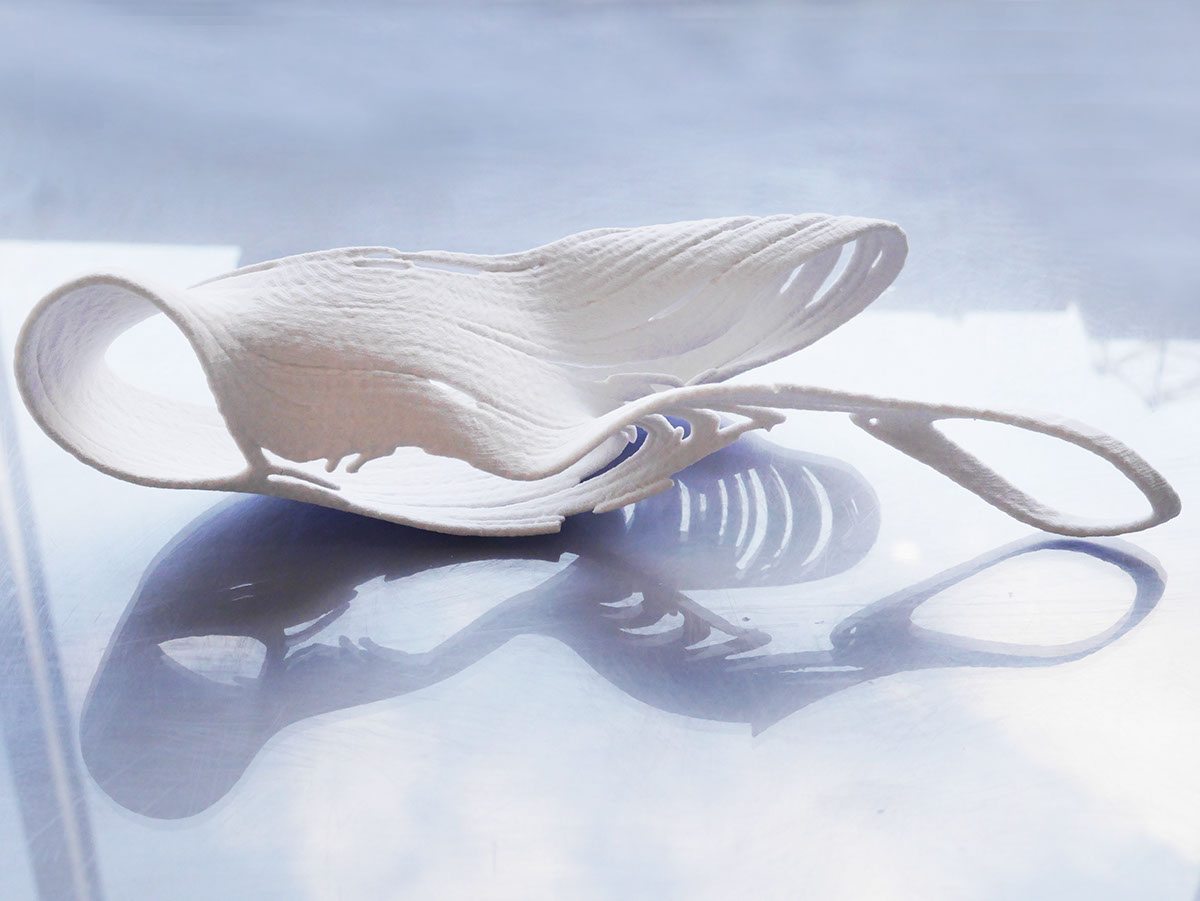
3d printed model representation of the outter shell
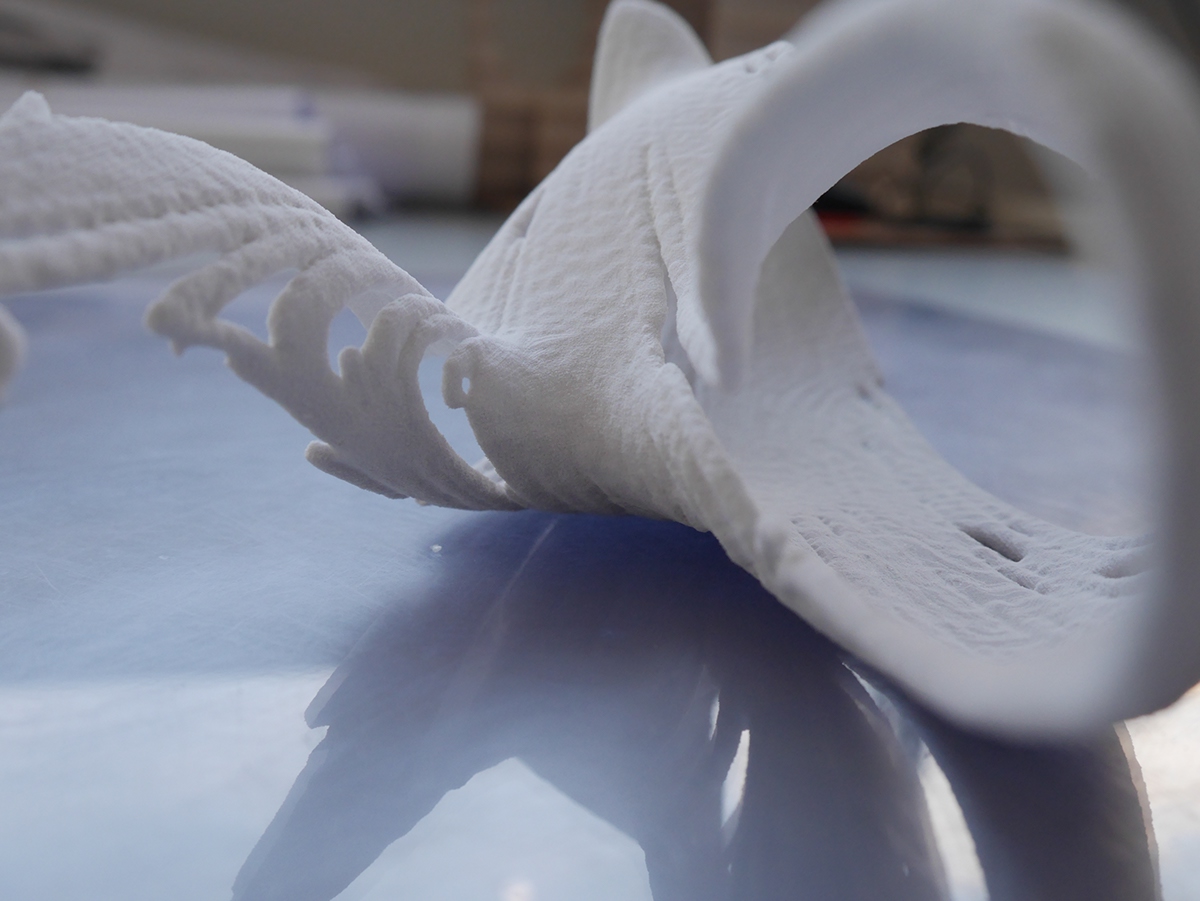
3d printed model closer look
We decide to place the structure to this location because of the isles. There is a bridge which connect the two countries and make feasible the passage from one to another. The spots with more concentration of meshes can be closed spaces, ideal for habitation.
Moving to the phases of structure. There are four different qualities. The starting point is the lines of the magnetic field on which we designed the first mesh. On this mesh we applied a second magnetic field. The second field lines started to develop from the both sides to the center of the mesh. on these lines we design a new time of meshes with lead as to the final form. The new meshes, also develop from the sides to the center gradually. So in case of a problem between the two countries the structure on the banks can be stable and still be used from the citizens while the central part can be deconstructed.

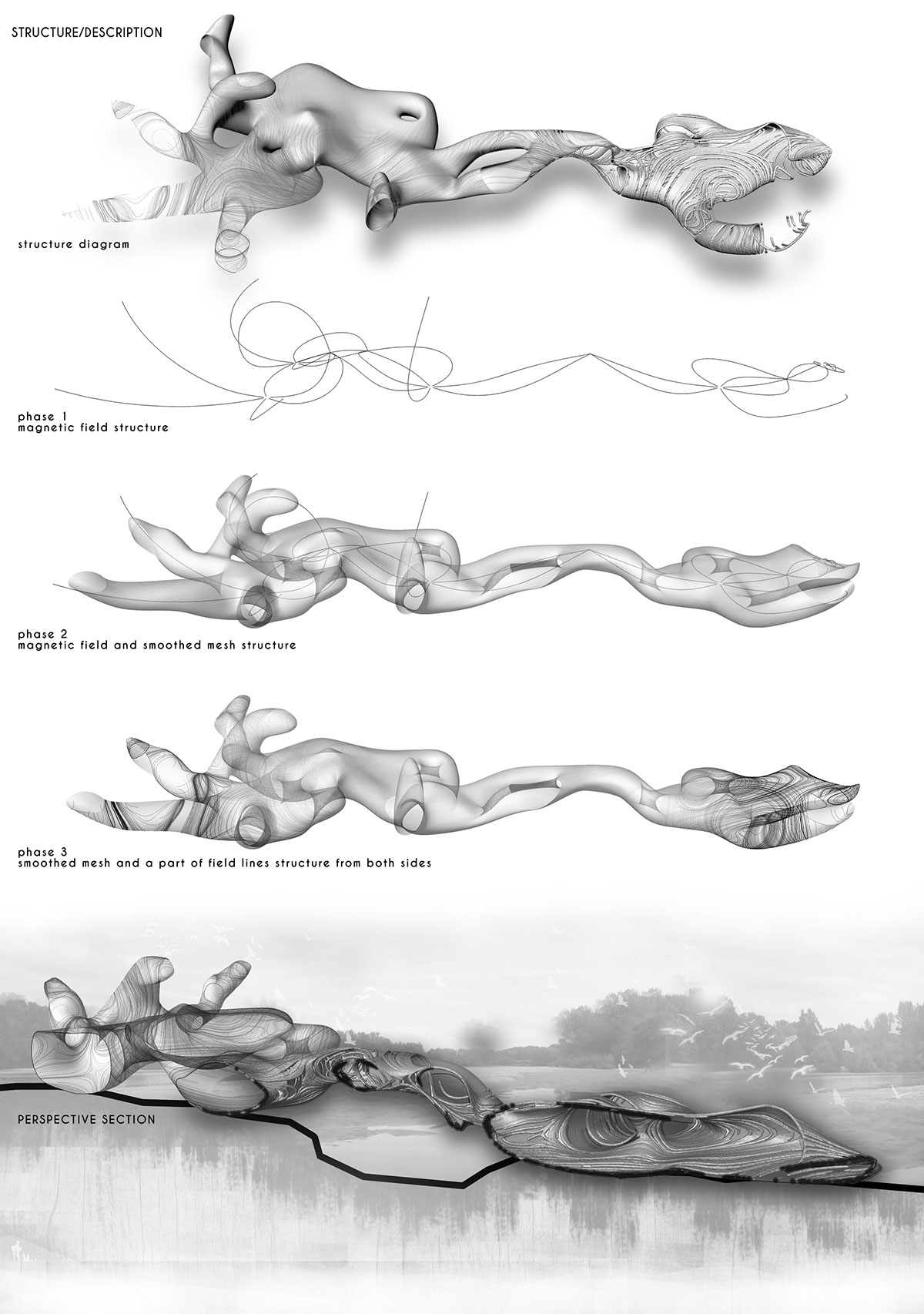

The physiology of the location and the structure is more intense in the next two photorealistics.
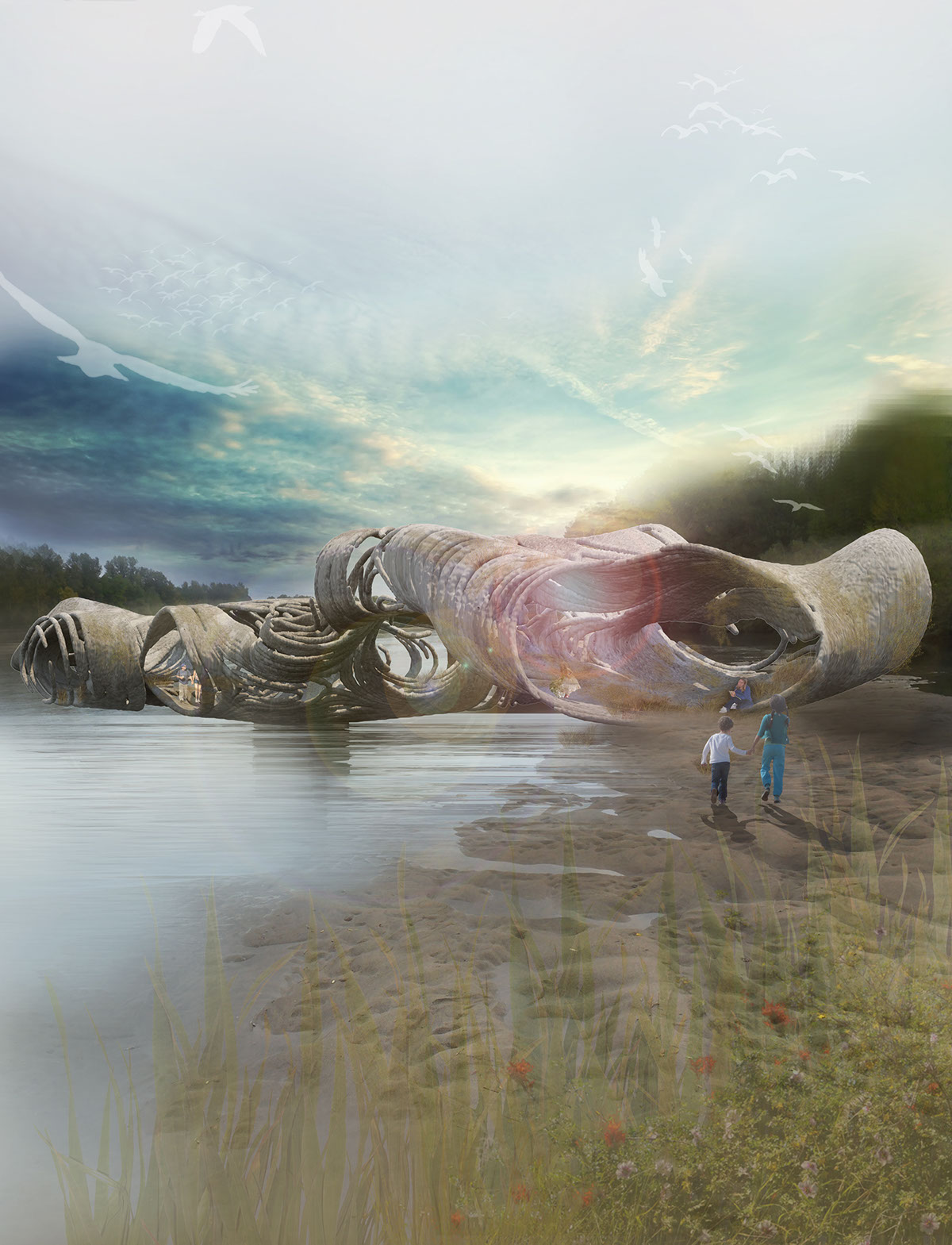

Two more alternatives for this project are shown, because we do not see this design as a permanent structural element but rather as a mutative ecology. Two more simple versions of it follow next, one alternative as a shelter and one as a floating pavilion for research of the river and as a creation of an experiential relationship with the water.
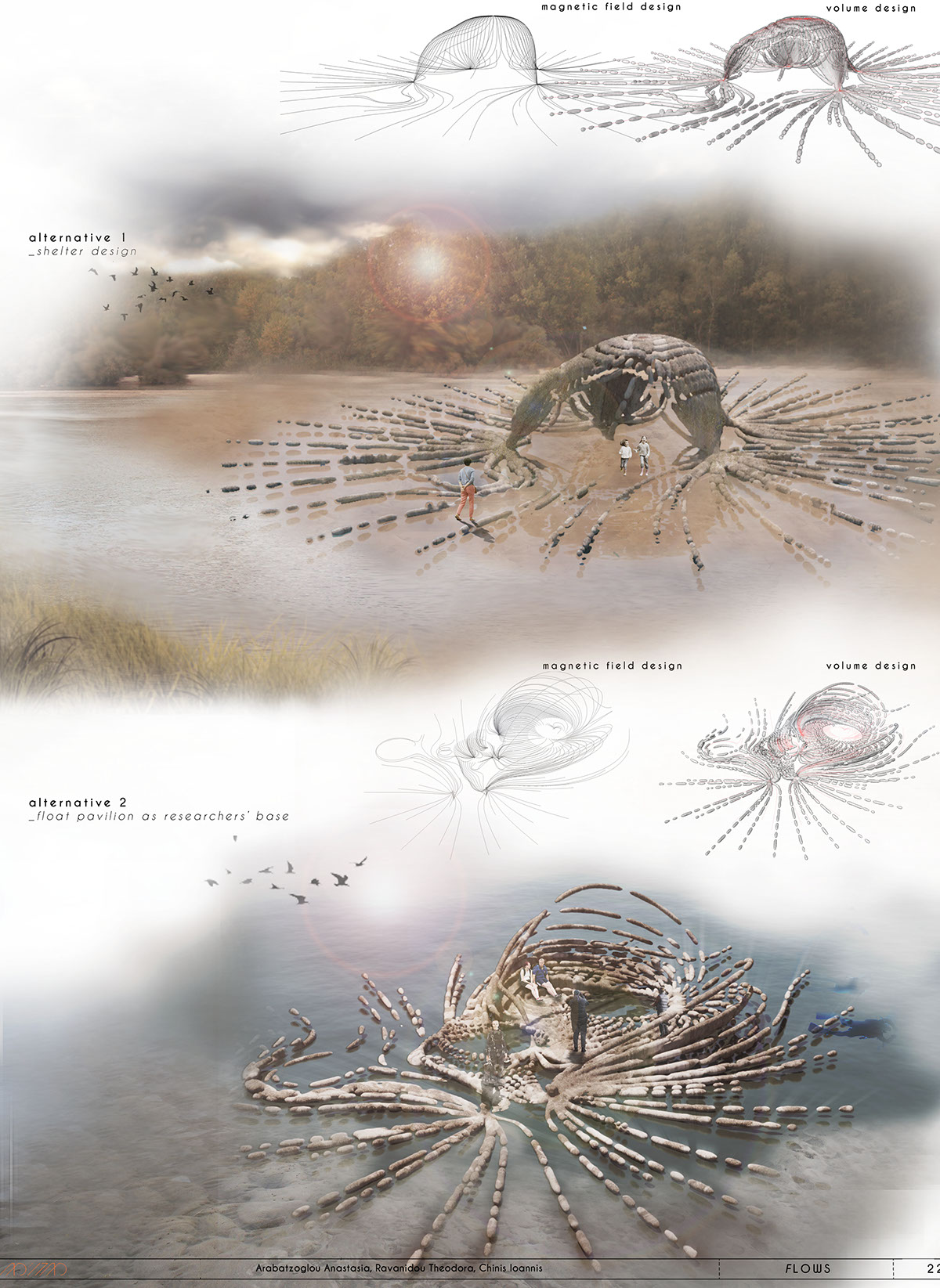
At this point, in accordance with the changeable and mutable physiology of the project, our research is oriented to biodegradable materials. Materials that could be retrieved from the specific natural ecology and return at after they complete their cycle. A solution that is under consideration for the time, is a mixture consisting of soil, agricultural wastes and being reinforced by biodegradable resins. Considering the structural complexity of the structure and the limitations that its temporariness arises, the development of a 3D printing system, would be something to consider about on a later stage.
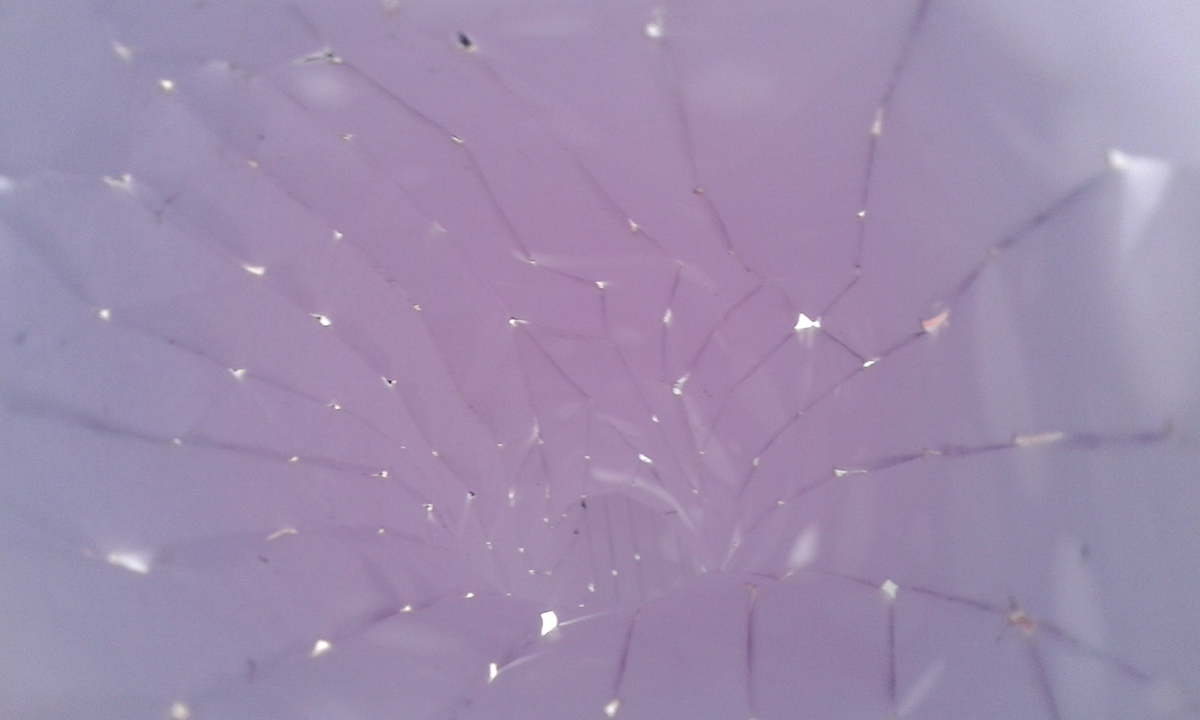
model representation of starting volumes. perforated surfaces, skin creation using triangulation method


